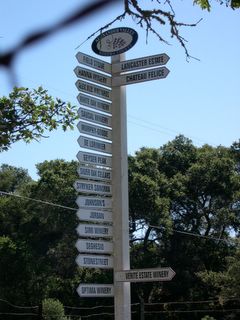That tensions are high is clear. Last week 800 winegrowers gathered for an acrimonious demonstration outside the office of the Winegrowers Union of Beaujolais in the small town of Villefranche-sur-Saone, capital of the district. 'Revolution' screamed the front page of the local newspaper, Le Patriote-Beaujolais...
This is what you get for suggesting that producers are going to need to reduce the amount of wines they make by 10%...
Nice.
But then again, it's a valid point that nobody would like to see their income reduced 10%....even if it was for the long term stability of the region's wine prices.
De Longevialle [the ousted President of their union /huge], whose family have been making wine at their stunning Chateau de Vaurenard estate for three centuries, denied that the conflict pitted the older, wealthiest winemakers against the less well off. 'The attacks on me have been sustained and personal. But it's the law of the market that is behind the problem,' he said. 'We have to do something before this harvest creates another huge surplus.'
So, he gets the axe for thinking forward and suggesting that which they all know they need to do...and in his defence he's suggesting the burden should be shouldered equally by all, not just a few on the lower end of the scale.
Though there may be some truth in what they are saying; older established wine families have more clout, and better reputation and path to market in France, where smaller new producers have more risk with the 10% cut. I'll go on record as stating that the reductions in amounts produced should be pro-rated for the wines which are in surplus:
if Cht. "X" has sold all of it's vintage, then it should be encouraged to do the same again the next year with simmilar production quotas.
If Cht. "Z" has 75% of it's wines in surplus, then obviously it shouldn't be producing that much, and should see at least a 50% drop in what it's bringing into the marketplace. Should they see a future turn-around, they can get the OK to increase in subsequent harvests.
Quotas are pretty much the only thing you can do if you're going to continue to have subsidies from the Gov't. Ideally, the market would relinquish the subsidies, and turn to a sales driven paradigm.
Sink or Swim...
Sell or Perish...
It's the only real way to get back out of these huge payouts (and distillation schemes) the EU is being held to, and places the burden squarely on the shoulders of the individual vignerons, where it should always have been anyway...and it won't be pretty...
Subsidies should be for emergencies, not the everyday way businesses are supported. And with 1 million bottles of the previous vintage in surplus (almost 50% of the annual production), it's quite obvious something needs to be done.
And they'll have to face the facts...bottle-aged Beaujolias Nouveau just doesn't sell that well. It's made for immediate drinking, not cellaring. Sounds like it's going to be more calls for Gov't subsidies, more rioting, protesting (perhaps even more monkey-wrenching), and eventual distillation for industrial alcohol.
That vicous cycle just doesn't make good business sense, for anybody...










